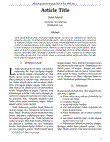Search Results - "Grasse"
Suggested Topics within your search.
Suggested Topics within your search.
-
1
-
2
Allergen sensitization linked to climate and age, not to intermittent-persistent rhinitis in a cross-sectional cohort study in the (sub)tropics
Published 2014“…Conclusions: In a country with (sub)tropical climate zones SPT sensitization patterns varied according to climatological zones; they were different from those found in Europe, HDM sensitization far outweighing pollen allergies and Bermuda grass and Ash pollen being the main grass and tree allergens, respectively. …”
Get full text
Article -
3
Simulación estocástica para praderas de pasto buffel ( Cenchrus ciliaris L.) en Marín, N. L., México
Published 2014“…Model simulates the monthly production of dry matter of green grass, as well as its conversion to senescence and dry grass and eventually to mulch, depending on precipitation and temperature. …”
Get full text
Article -
4
Ecología trófica y evaluación del hábitat de Ovis canadensis mexicana, Ammotragus lervia y Odocoileus virginianus texanus en Coahuila, México
Published 2020“…The arboreal, scrhubs and grasses were the most important species. The diversity, richness and dominance of species were higher in autumn. …”
Get full text
Tesis -
5
Ecología trófica y evaluación del hábitat de Ovis canadensis mexicana, Ammotragus lervia y Odocoileus virginianus texanus en Coahuila, México
Published 2020“…The arboreal, scrhubs and grasses were the most important species. The diversity, richness and dominance of species were higher in autumn. …”
Get full text
Tesis -
6
Role of Marine Metabolites in Shrimp Growth, Production and Disease Prevention
Published 2017“…The in vitro and invivo tests of extracts containing metabolites isolated from marine macroalgae, sea grasses and invertebrates inrestraining the proliferation of disease causing microbes are presented. …”
Get full text
Article -
7
Population density of the western burrowing owl (Athene cunicularia hypugaea) in Mexican prairie dog (Cynomys mexicanus) colonies in northeastern Mexico
Published 2016“…Background: The western burrowing owl (Athene cunicularia hypugaea) occurs throughout western North America in various habitats such as desert, short-grass prairie and shrub-steppe, among others, where the main threat for this species is habitat loss. …”
Get full text
Article -
8
Phenology of woody species: a review
Published 2014“…Elevated temperature strongly influences greater in C3 plants than in C4 plants but the disadvantages of warming may be considerably attenuated by elevated CO2, especially for C3 grasses. Species with high wood densities can able to store only limited quantities of water in their trunks; leaf fall in these species occurred during the dry season. …”
Get full text
Article -
9
Predicción de la Digestibilidad de Proteína en el Camarón y Uso de Ingredientes Proteicos de Segunda Generación en Alimentos para Acuicultura
Published 2019“…C. and Pan, B.S., 1993. in vitro digestibility simulating the proteolysis of feed protein in the midgutgland of grass shrimp (Penaeus monodom). Aquaculture, 109:59-70.Pederson, B. and Eggum, B.O., Prediction of protein digestibility an in vitro enzymatic pH-stat procedure.Tierphysiol, Tieternahrg u Futtermittelkde, 49: 277-286. (1983).Papadopoulos, M. …”
Get full text
Article -
10
Caracterización del hábitat de Amoreuxia wrightii (Bixaceae), una especie en peligro de extinción en el noreste de México
Published 2018“…Key results: According to the relationship with other species, A. wrightii was associated with pioneer species that emerge after disturbance, dominated by grasses like Aristida purpurea, Cenchrus ciliaris, Cynodon dactylon, Panicum obtusum, herbs such as Gutierrezia sarothrae, Gymnosperma glutinosum and Parthenium hysterophorus, and low shrubs like Acacia amentacea, A. berlandieri and Eysenhardtia texana. …”
Get full text
Article -
11
Ocurrencia de fumonisinas totales y FB₁ en forrajes henificados destinados al consumo equino.
Published 2017“…Our investigation showed that different types of forages are used in equine feed, being Cynodon spp. grass the most commonly used. Additionally, we found the highest FBs concentrations during summer and winter in all stables, unlike autumn and spring (P > X2 0.0002). …”
Get full text
Tesis -
12
Estudio prospectivo y tetrospectivo de la incidencia y prevalencia de fracturas de la tercera falange en potros warmblood y su relación con la claudicación
Published 2017“…On the second stage, a prospective study was designed in which radiographs of the third phalanx of both forelimbs of 35 foals were taken at 1week, 1, 2, 4, 6, 8 and 10 months of age, all of them live under identical management conditions and are kept together as a group in grass paddocks. Results These records showed that the lateral palmar process of P3 was most commonly affected, involving 17 fractures in the right limb and 11 in the left limb. …”
Get full text
Tesis -
13
Ocurrencia de fumonisinas totales y FB₁ en forrajes henificados destinados al consumo equino.
Published 2017“…Our investigation showed that different types of forages are used in equine feed, being Cynodon spp. grass the most commonly used. Additionally, we found the highest FBs concentrations during summer and winter in all stables, unlike autumn and spring (P > X2 0.0002). …”
Get full text
Tesis -
14
Estudio prospectivo y tetrospectivo de la incidencia y prevalencia de fracturas de la tercera falange en potros warmblood y su relación con la claudicación
Published 2017“…On the second stage, a prospective study was designed in which radiographs of the third phalanx of both forelimbs of 35 foals were taken at 1week, 1, 2, 4, 6, 8 and 10 months of age, all of them live under identical management conditions and are kept together as a group in grass paddocks. Results These records showed that the lateral palmar process of P3 was most commonly affected, involving 17 fractures in the right limb and 11 in the left limb. …”
Get full text
Tesis -
15
Dieta invernal de tecolote llanero (athene cunicularia) y su interacción con dos especies simpátricas: búho cuerno corto (asio flammeus) y lechuza de campanario (tyto alba), en el...
Published 2014“…It was found an average of 6.3 categorized habitats per individual convex polygon, showing a marked preference for low density short grasses and crops. Burrowing Owl population in Irapuato showed a high response to burrow availability along furrows conformed by ripped soils in two contiguous plots of 25 and 19 ha. …”
Get full text
Tesis -
16
Dieta invernal de tecolote llanero (athene cunicularia) y su interacción con dos especies simpátricas: búho cuerno corto (asio flammeus) y lechuza de campanario (tyto alba), en el...
Published 2014“…It was found an average of 6.3 categorized habitats per individual convex polygon, showing a marked preference for low density short grasses and crops. Burrowing Owl population in Irapuato showed a high response to burrow availability along furrows conformed by ripped soils in two contiguous plots of 25 and 19 ha. …”
Get full text
Tesis -
17
Incidencia de estados serales sobre la diversidad de aves y el uso de su habitat en el bosque tropical subcaducifolio, Jalisco, México
Published 2005“…This study was development in three seral stages: Tropical Subdeciduos Forest (BTSC), Secondary Vegetation (VS), Shrubs Vegetation (MT), and Grasses (PZ). Five sites of sampled were used in each one of the seral stages; each site was separated with 150 m in a transect of 750 m. …”
Get full text
Tesis -
18
Incidencia de estados serales sobre la diversidad de aves y el uso de su habitat en el bosque tropical subcaducifolio, Jalisco, México
Published 2005“…This study was development in three seral stages: Tropical Subdeciduos Forest (BTSC), Secondary Vegetation (VS), Shrubs Vegetation (MT), and Grasses (PZ). Five sites of sampled were used in each one of the seral stages; each site was separated with 150 m in a transect of 750 m. …”
Get full text
Tesis


